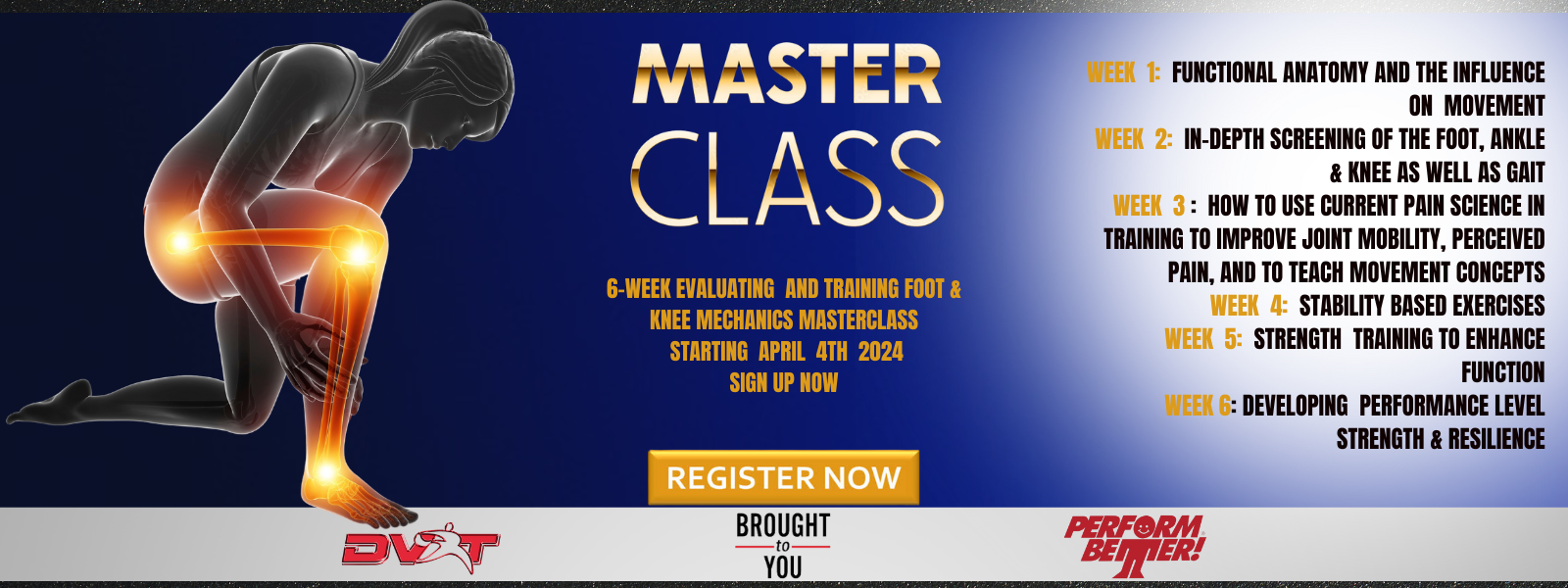What Really Improves Balance Training
2024-03-12
Jessica Bento, Physical Therapist (Creator DVRT Restoration Certification, DVRT Rx Shoulder, Knees, Pelvic Control, & Gait Courses)

As you have read over and over again here at DVRT, is how important the foot is, but it still tends to be one of those topics that people don’t discuss enough, coach enough or understand enough so I thought, hey, why not another blog in the foot!
An interesting fact is that foot problems can lead to fall risks especially in the geriatric population. I can tell you from past experience working in fall prevention clinics that almost everyone that came in to see me for balance issues also had issues going on in the foot and ankle complex.
One study stated, “Furthermore, older people with a history of multiple falls have greater foot impairment than non- or once-only fallers. These findings provide further evidence that foot problems are a falls risk factor and suggest that the cumulative effect of multiple foot problems is more important in increasing falls risk than the presence or absence of individual foot conditions.”(1)
Another article concluded, “Foot pain, especially from plantar fasciitis, increased risk of falls in healthy older persons. Foot assessment, foot pain management, and proper footwear play important roles in fall prevention.” (2)
There is study after study looking at foot problems and the correlation between things like risk of falls, gait disorders and movement dysfunction. That is why is so important to look at the foot. Often times people don’t think to screen the foot and so much can be missed when trying to hep an individual.
One of the main things I see when working with individuals with balance issues is ankle mobility and again, especially when you get into older populations. If you lack ankle mobility then your gait can be off, and that can cause greater issues up the chain like knee, hip or low back issues as well. Remember when the foot hits the ground everything changes and in order to have proper gait mechanics you need full ankle mobility.
The best thing you can do is check your own ankle mobility or make sure you are screening your clients or patients even if they are not seeing you for foot pain. Below I have an easy ankle screen to do so address your ankle mobility.

Now, if you find that you are lacking ankle mobility we can address that and work in improving that, above are some examples of how to not only improve ankle mobility but address the entire chain as well.
One thing that I see a lot in the older population as well is big bulky shoes. Now, I get that shoes are necessity but sometimes that causes us to lose a lot of how to properly use or engage our foot when they are supported in big shoes. Getting people out of their shoe can be very beneficial when perform certain exercises.
When it comes to barefoot training people often misunderstand the true intent. Yes, being barefoot is good and you can do similar things in specific training socks or minimus shoes, but the benefit of being barefoot is we can do some initial cuing that helps people understand the major point which is HOW we use our feet is the most important point!
Cuing the feet means learning how to create an “active foot”. Meaning the “core” of the foot becomes active and we can do so by simply giving feedback to the toes. We want the client to feel themselves grabbing for the ground as the more “awake” one’s foot is the better they will not only walk, but squat, lunge, hip hinge, but also push and pull.
Cuing isn’t the only we can get people to use their feet more, using a variety of stances and different movements (as you will see below) also forces people to learn to create the active feet that we are looking to develop. This helps with healthier knees, stronger glutes, and an overall better lower AND upper body.
When we create better foot stability, this can help our ankle mobility quite a bit. However, we can get faster and better results in our ankle mobility efforts if we do things such as…
-Work in different positions and angles.
-Give some additional feedback that will help the foot but also give some valuable pressure to the ankle.
-Add core stability that will enhance the mobility of distal joints and give us better ankle mobility.
Want to learn more? Don’t miss our upcoming Foot & Knee Masterclass HERE and right now, this week only, you can save 30% on our other online certifications, courses (the masterclass is not included), and Ultimate Sandbag equipment with code “spring” HERE
View this post on Instagram
- Menz, H. B., & Lord, S. R. (2001). The contribution of foot problems to mobility impairment and falls in Community‐Dwelling Older people. Journal of the American Geriatrics Society, 49(12), 1651–1656. https://doi.org/10.1111/j.1532-5415.2001.49275.x
2. Chaiwanichsiri, D., Janchai, S., & Tantisiriwat, N. (2008). Foot disorders and falls in older persons. Gerontology, 55(3), 296–302. https://doi.org/10.1159/000181149
© 2025 Ultimate Sandbag Training. Site by Jennifer Web Design.







